Leatherback sea turtles are also known as lute turtles or Dermochelys coriacea. Popular key behavioral facts of leatherback sea turtles are migration and deep diving. Due to their shell structure, unique vascular system, and connective tissue and bone layers, they can dive as deep as 4,000 feet in the ocean.
They can also swim more than 10,000 miles a year between their foraging and nesting seasons. Despite being found across the globe, they are still considered an endangered species due to human interference that poses a significant threat to their eating and nesting habits.
In the following discussion, we’ll delve into the growing, feeding, adapting, ecological, and other habits of this fascinating sea turtle species, providing you with a precise understanding of their behavior.
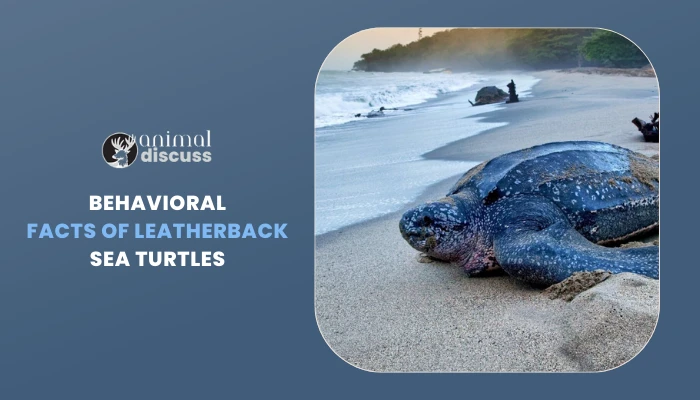
Overview of Leatherback Sea Turtle
For a comprehensive understanding of the intricate details of leatherback sea turtle behavior, here is a quick overview of their behavior facts:
| Behavioral Aspects | Behavior |
|---|---|
| Growing Habit: | The average size of a leatherback is 6 feet. As leatherbacks grow, they develop psychologically and structurally, which improves their swimming ability. Hence, leatherbacks can swim up to 10,000 miles a year. |
| Feeding Habits: | Leatherbacks primarily feed on jellyfish and sea squirts like tunicates, cnidarians, snails, small fishes, and cephalopods. When they hunt jellyfish or other marine life, they slowly approach it. They grasp and swallow their food with their strong beaks. |
| Breeding and Mating Habits: | During the nesting season, leatherbacks come to the shore for mating. Only female leatherbacks come out of the water to create their own egg chamber and lay eggs. |
| Aggression and Territorial Behavior: | Generally, leatherback turtles are calm and not aggressive. They do not harm people unless they danger caused by humans. Besides, they only hunt for their food-grade animals. |
| Social Behavior: | Leatherback sea turtles are solitary animals and do not interact with any other animals or humans. They only interact with female leatherbacks during the nesting season. |
To know more about Leatherback Sea Turtle
Why Do Leatherback Sea Turtles Behave Significantly?
Leatherbacks aren’t social; hence, they have a significant life cycle compared to other turtle species. As they grow up, their psychological and structural development help them to adapt to the sea environment.
And due to these ability developments, leatherbacks can swim faster and dive deep into the sea. Besides, leatherbacks are habituated to feed on jellyfish and soft-bodied marine organisms.
The reason behind the habit of feeding jellyfish and soft marine life is that leatherbacks don’t have teeth. However, their strong beaks help them to swallow soft foods.
Significance of Understanding the Diversified Behavior of Leatherback Sea Turtle
These highly migratory predators are the primary source of balancing marine ecosystems. Leatherback sea turtles consume gelatinous zooplankton, which is a significant part of the aquatic food chain.
Unfortunately, these turtles are gradually becoming extinct, and their disappearance could have a negative impact on the marine ecosystem’s balance.
To prevent this, people should learn about the behavior and life cycle of leatherback sea turtles. This knowledge will help people understand the importance of these creatures and find ways to protect and preserve them.
Growing Habits of Leatherback Sea Turtles
Among all the sea turtle species, leatherback turtles are the largest turtle species living on earth. They are also known as the most migratory turtle species. Here are some growing facts about leatherbacks:
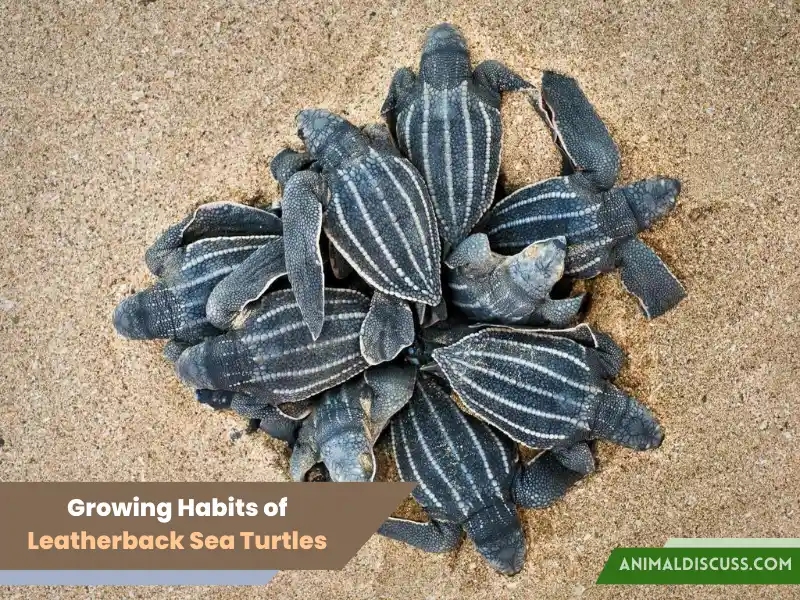
Size and weight: Leatherback turtles can grow in length between 4-6 feet and weigh between 650-1,200 pounds.
Unique Shell: Their shell is a unique physical feature. You can spot black or dark gray leatherback turtles with white, blue, and pink small spots on sea shores.
Lifecycle:
- When a leatherback turtle hatches from its egg, it can take between 3 to 7 days to make its way to the sea from the shore. During this time, baby leatherback turtles mostly become prey to birds, animals, or other predators.
- Mostly, their childhood is spent struggling to survive by hunting animals. Between the age of 7 to 16, leatherback turtles reach maturity and turn into their adulthoods.
- Mature female leatherback turtles go back to their natal beaches in order to nest. And mature male leatherback turtles spend their entire adulthood in the sea.
- They usually nest in sandy beaches as eroded beaches damage their soft shells.
- In old age, they eventually die due to health problems or become prey to predators.
Leatherback turtles grow up ingesting plastic bags, fishing lines, balloons, floating tar, and other materials abandoned in the sea by humans.
Besides, they tend to be entangled with discarded fishing gear or marine debris, which can seriously injure or kill them.
Structural Adaptations
As leatherback turtles grow up, they adapt to some structural developments. For example:
- They have a smooth carapace that helps them to glide through the water easily.
- The leatherback turtle’s carapace is leathery and has hydrodynamic ridges, which diminish into a blunt point as it grows.
- Their limbs sprout into flippers that act as a large paddle. Hence, they can migrate long distances at sea effortlessly.
They also have eating structural adaptation. For example:
- Leatherback turtles develop backward-pointing spines across their throat and mouth that help them to grip and swallow their food.
Leatherback turtles develop their hearing ability via bone conduction. Their whole body acts as a receptor. When sound passes through their soft tissue and bones, it energizes their inner ear directly. Therefore, they have weak acoustic receptors.
Feeding Habits of Leatherback Sea Turtles
Jellyfish are the primary food for leatherback sea turtles because of their frail jaw. They also feed on sea squirts like tunicates, cnidarians, snails, small fishes, and cephalopods.
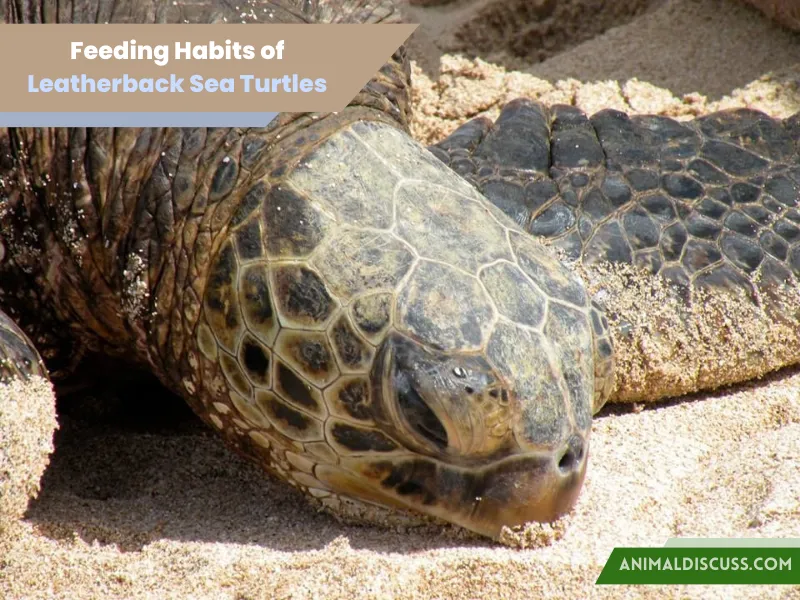
However, baby sea turtles have different foods. They mostly prey on crustaceans, sargassum seaweeds, fish eggs, hydrozoans, and jellyfish.
Hunting Tactics: Adult leatherback turtles hunt food through migrations. They can cross the Pacific Ocean to the US West Coast to hunt jellyfish. When they find prey, they slowly approach it and grasp it with their sharp beaks and jaw to crush it.
Breeding (Mating) Habit And Migration Patterns
Once a female leatherback turtle enters its mature age, they tend to return to where they were born to lay eggs.
However, male leatherback turtles never leave the water. During their mature age, male sea turtles migrate to the shoreside (usually near nesting beaches) before the nesting season. During this stage:
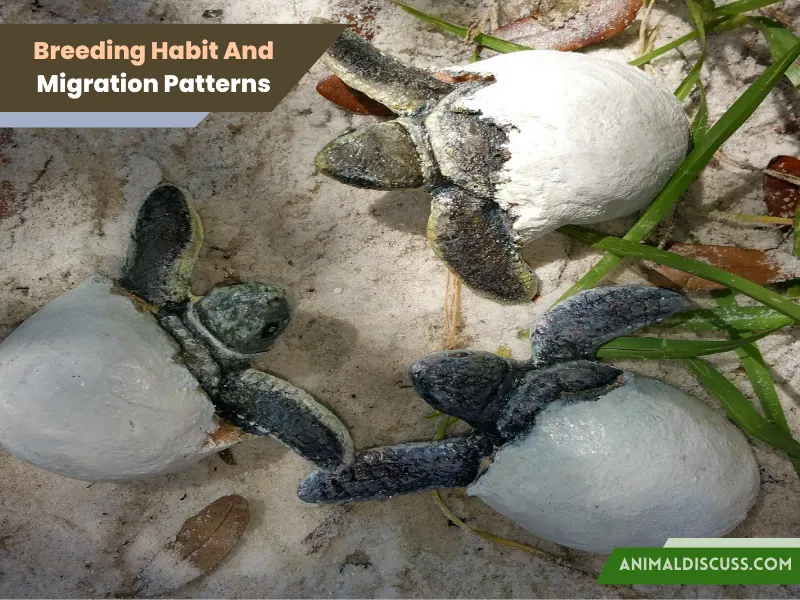
Mating season: Male leatherback sea turtles mate before the nesting season. Usually, there are two nesting seasons in a year: summer and winter.
The summer nesting season starts in July and ends in September, whereas the winter nesting season lasts from November to February.
Mating ritual: Male leatherback turtles try to mate with as many female sea turtles as possible. Female leatherback turtles only mate and lay eggs once every 2-3 years due to lack of energy.
Male leatherback turtles remain active in the mating process throughout the year.
Moreover, female turtles sometimes go back to the sea if they find their desired nesting beach unsuitable for laying eggs. Except for the part of mating, male leatherback turtles don’t participate in any nesting process.
Here are some more facts on the numbers and incubation of leatherbacks:
- Female leatherbacks create a 75 centimeters-deep egg chamber in the sand.
- There, they lay about 70 to 110 eggs.
- Female leatherbacks take 8 to 12 days to complete their laying process.
- Around a total number of 400 to 700 eggs are laid by female leatherbacks during the nesting season.
- 85% of eggs are able to hatch.
After laying eggs, she covers the eggs with sand in the nest to create a warm environment for the hatch and prevent predators’ attacks. Then female leatherbacks go back to the sea.
Among all the hatchlings, only 25% will make it to the sea, and only 6% of the surviving hatchlings will survive in the water. This is literally the primary reason why there is a low number of leatherback sea turtles population.
How Do Hatching Eggs Turn into Male or Female?
Generally, the temperature of the nest determines the gender of the hatchlings. For example:
- Hatching incubated lower than 28.75°C will be male
- At 29.5°C, hatching eggs have an equal possibility of being male or female.
- Hatching incubated above 29.75°C will be female.
Ecological Adaptation of Leatherback Sea Turtles
Leatherback sea turtles have a significant role in the ecosystem. Such as:
- They mostly hunt jellyfish and other soft-bodied sea organisms. As a result, leatherbacks keep the population of these marine lives under control.
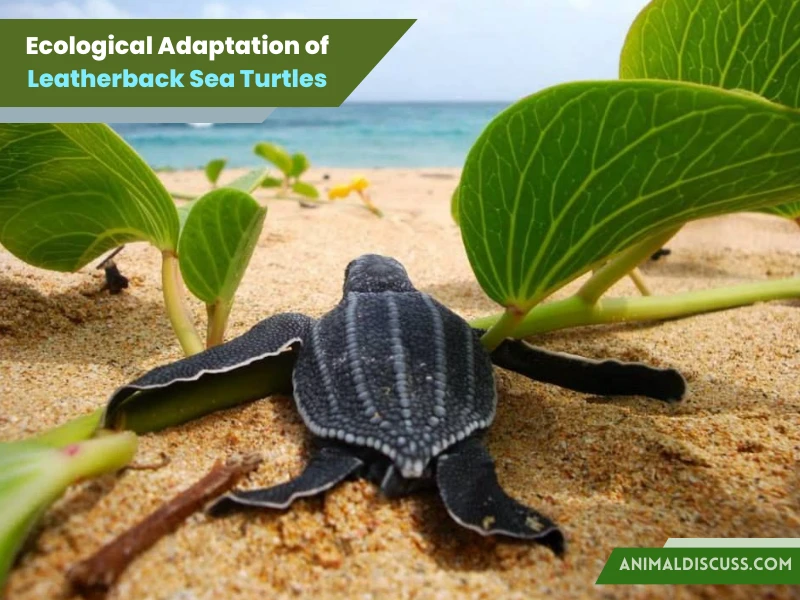
However, their effect on these prey populations is unknown. Moreover, the hatching eggs of the turtles can be a source of food for many marine lives and birds. Besides, they are a great economical source for humans with both positive and negative impacts. For example:
- Adult leatherback turtle flesh is less toxic. Hence humans can sell leatherback turtle flesh.
- Their eggs are edible.
But old turtles’ flesh is suggested not to eat as they are more toxic for humans.
Psychological Adaptations
Psychological adaptations impact the overall behavioral facts of leatherback sea turtles. Every marine lives have to deal with ocean salinity to survive. Here are some examples of leatherback psychological adaptations:
- Leatherback sea turtles contain larger lachrymal salt glands near the eye cavity. As a result, they can get rid of more sea salt compared to other turtle species. However, it seems like sea turtles are crying when they release salt water through their glands.
- Leatherback turtles have special skills for holding their breath and withstanding intense pressure. With these skills, leatherback sea turtles can dive up to 1,200 meters.
- They can’t breathe underwater with their large and flexible lungs. Hence, they need to come out to the water’s surface to breathe every hour.
- Their leathery carapace helps them to withstand pressure effectively.
- Leatherback turtles can also slow down their heart rate with sleeping; it helps them save energy and oxygen.
- Leatherback turtles contain a thick layer of body fat that helps them maintain and produce body heat.
- They have unique blood vessels that keep them warm in cold water.
- With these psychological adaptations, they can maintain a core body temperature of 18.2°C in cold water.
- Leatherback turtles fall at great risk under 10°C body temperature.
Aggression And Territorial Habits of Leatherback Sea Turtles
Leatherback Sea turtles don’t possess any aggression or territorial habits towards other animals, including sea turtles. But they attack small and soft marine life during food hunting.
As leatherbacks are calm, they usually don’t get into a fight with other large sea animals. They only come out of the water during mating and nesting season. Otherwise, they typically live deep under the water.
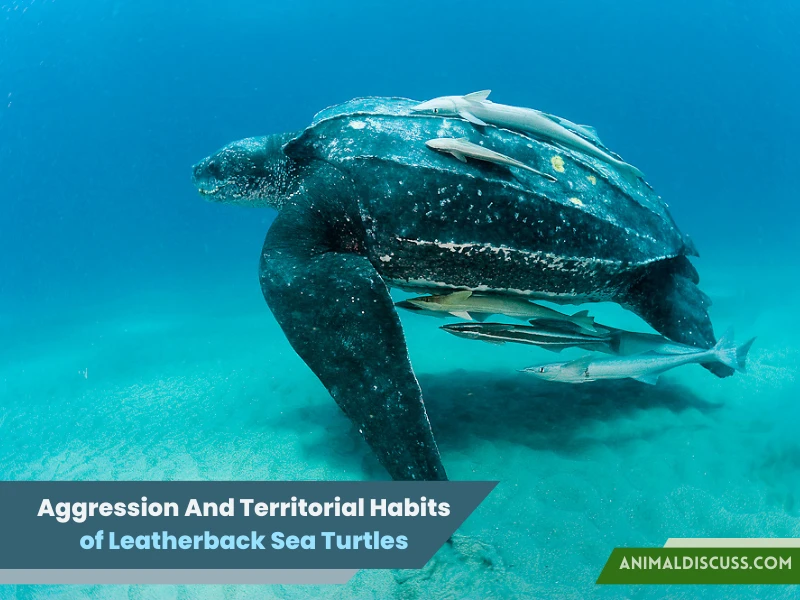
However, they may show some territorial behavior during mating season. Males may become territorial and aggressive towards other males to secure a mate. This can lead to head-butting and biting.
Besides, female leatherback sea turtles may also exhibit territorial behavior when nesting on beaches. They become aggressive towards other females who try to nest near their nesting chamber.
Additionally, there’s minimal interaction between them and humans. However, they may act aggressively and attack people if they sense any danger for themselves created by humans.
In that case, leatherbacks may bite to defend. Though they don’t have teeth, their solid beaks and powerful jaw muscles can leave severe bruises or break bones. Therefore, it’s recommended not to provoke them if you find one on the shore.
Social Behavior of Leatherback Sea Turtles
Generally, leatherback sea turtles are solitary animals who don’t have any special social behavior. Sea turtles usually gather together during the breeding season.
Both male and female leatherback turtles travel to nesting beaches from the deep ocean. Once the mating season is over, male turtles travel back into the deep water in their solitary.
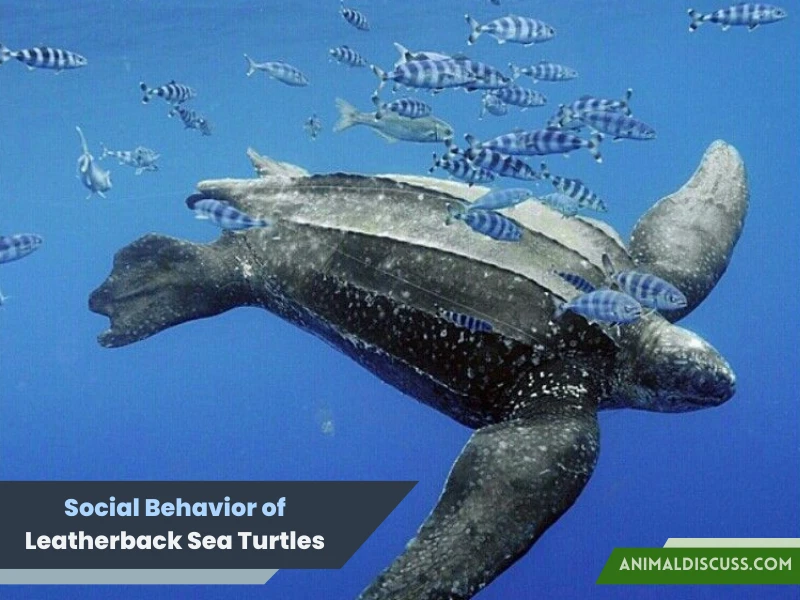
And female turtles go back into the sea after laying four to seven eggs in a clutch. Leatherback sea turtles primarily use their sense of sight and smell to find food and move around.
Additionally, they may use gestures like head movements and postures to communicate with other sea turtles or marine animals during interactions.
However, the exact types of body language they use for communication are hardly documented or understood.
Human-Induced Facts That Changes The Behavior of Leatherback Sea Turtles
Here are some key human-induced factors that impact the change in leatherback sea turtles’ behavior:
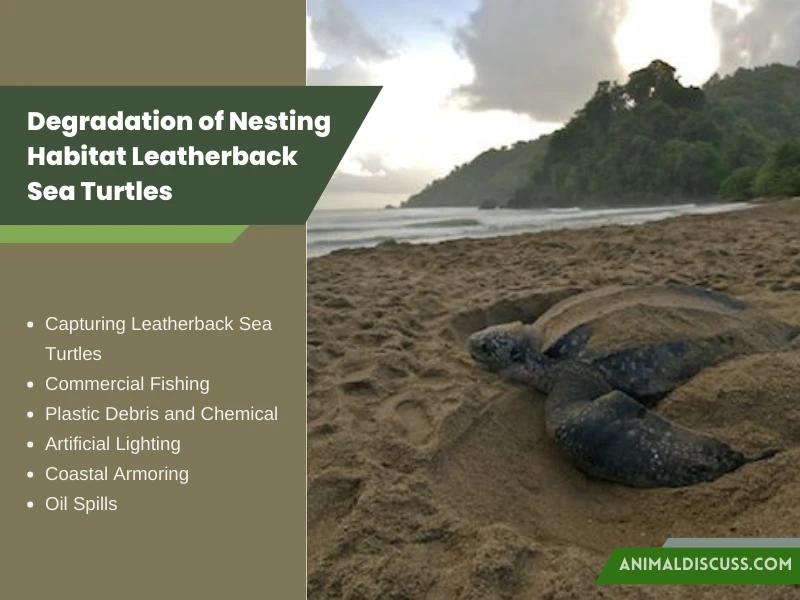
Degradation of Nesting Habitat
Creating sea beaches for foreigners, arrangement of bright lighting, and beach diving are common human-related coastal developments.
These human activities are influencing the nesting habits of leatherback sea turtles as these developments increase nesting habitat degradation.
Capturing Leatherback Sea Turtles
When the female leatherback turtle comes to their nesting beach, some people capture it from the nest and wait till she lays her eggs. After that, they kill the female turtle to capture its eggs, then sell them in the local market.
They also collect the meat, shell, skin, oil, and cartilage of the dead leatherback turtle to earn some extra. Although such business is illegal in many countries, some coastal communities, like Asia and Central America, do this business.
Commercial Fishing
Every year, thousands of leatherback turtles get injured by commercial fishing gear when they come up to the surface to breathe. Consequently, leatherback turtles prefer to migrate to the ocean, where people don’t usually go fishing.
Plastic Debris and Chemical
As the primary food of leatherback turtles are jellyfish, they mistake a floating plastic bag for jellyfish and consume it. People usually throw the debris in open places near rivers and streams.
It eventually flies away into the seas with storms or heavy winds. Again, the number of mills and factories are increasing, which releases toxic chemicals into the sea.
As leatherback turtles swallow plastic bags and drink polluted water, they become weak and lose the ability to lay eggs.
Artificial Lighting
Leatherback turtles require dark beaches to successfully reproduce, but human development and artificial lighting on sea beaches are making it difficult for them to find suitable nesting sites.
Therefore, turtles need to compete with tourists and residents to use their preferred beaches. These beach developments are also creating obstacles in leatherbacks’ nesting process.
Coastal Armoring
Leatherback sea turtles swim a long distance to their nesting beach or where they were born to lay eggs. But residents are trying to protect their states from sea calamities by building coastal armoring, like rock revetments, walls, and sandbags.
These man-made barriers on the seashores prevent leatherhead turtles from entering their desired nesting and reproducing. For example, around 40% of Florida beaches are categorized as eroded beaches, making them less optimal for nesting.
Oil Spills
This human-induced issue can also be categorized under marine pollution. Water pollution kills small and weak marine life that counts as food for leatherhead turtles. Not only oil spills, fertilizers, petroleum, and urban chemicals are equally harmful to this sea turtle species.
Conservation Status of Leatherback Sea Turtles: Efforts To Take for Conservation
Since 1970, leatherback sea turtles have been categorized as endangered animals by conservationists in the US. Around 70 or 80% of female leatherback turtles have decreased from their total population in the last decade.
Behind their gradual extinction, marine pollution, sea beach developments, egg harvesting, and commercial fishing are the primary reasons.
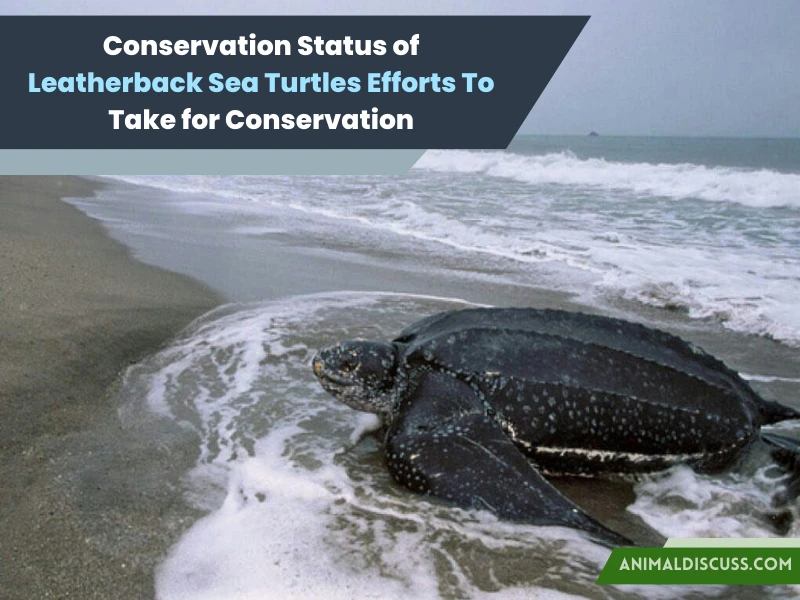
Even Florida’s Endangered and Threatened Species Act protects the leatherback turtle as an endangered species. To protect the existence of leatherback turtles, Florida statutes make it illegal to sell, take, molest, mutilate, and harm the turtles’ nests and eggs.
Besides, the law has issued a new rule requiring federal permission to possess a leatherback turtle for education or scientific activities. The same applies to possessing hatchlings or turtle eggs.
Also, in July 2004, the Marines Turtle Conservation Act in the US started a new law of aiding and preserving nesting habitats, including sea turtles. Foreign countries also participated in this practice according to the contracts.
Aside from organizations, and governmental efforts, people also should take part in the conservation of this turtle species. Here’s what people can do to save them from going extinct:
- Raise awareness and prevent throwing debris and chemicals into the sea.
- Participate in a coast clean-up program to reduce plastic, shopping bags, polyethylene bags, and other debris.
- Prevent building a wall barrier on the shoreside.
- Don’t throw fishing equipment into the sea, and go slow with your boat to prevent accidentally killing or injuring a leatherback sea turtle.
- Keep sea beaches dark to create an optimal nesting beach for female leatherbacks.
- Try filling holes and breaking sandcastles in the beach to element obstacles for hatchlings to go into the water.
Frequently Asked Questions
Here are some commonly asked questions by people about Leatherback sea turtles:
01. How many leatherback turtles are left on the earth?
Determining the precise number of leatherback turtles remaining is challenging as male turtles do not leave the water.
However, studies suggest that the population of female leatherbacks has decreased by 25% in the past two decades.
Presently, it is estimated that there are 30,000 to 40,000 nesting females remaining worldwide.
02. Do leatherback turtles mind when they are around other turtles?
It’s normal to have this thought, as leatherback turtles are not social.
However, they don’t mind the presence of other sea turtles around them. Both male and female leatherback turtles usually don’t interact among themselves or with other animals except during their mating stage.
03. What is “The Lost Years” in leatherback turtles’ life?
Scientists have given this name to the stage of leatherbacks, from hatchlings to juveniles.
It usually takes 12 to 15 years for leatherbacks to reach adulthood, but during this time, their whereabouts are unknown. Therefore, their life before maturity is known as The Lost Years.
Conclusion
So, there are many behavioral facts about leatherback sea turtles that impact its life. From hatching to old age, leatherback turtles live in a significant cycle of hunting foods, mating, and laying eggs.
When baby turtles hatch, they fight their way to the sea. In their adulthood, they mate and lay eggs. For the rest of their lives, they mostly live on migration in search of food or finding their desired nesting beaches.
The leatherback sea turtles also have specific feeding habits such as small fish, jellyfish, and other soft-bodied marine life. Continue learning more about their food habits, habitats, and adaptation from our homepage.
References:
- https://wildwhales.org/speciesid/sea-turtles/leatherback-sea-turtle
- https://www.fisheries.noaa.gov/species/leatherback-turtle
- https://www.flrules.org/gateway/ChapterHome.asp?Chapter=68A-27
- https://conserveturtles.org/information-sea-turtles-threats-sea-turtles/
- https://www.ncbi.nlm.nih.gov/pmc/articles/PMC2978089/
- https://www.fisheries.noaa.gov/national/marine-life-distress/cold-stunning-and-sea-turtles-frequently-asked-questions

